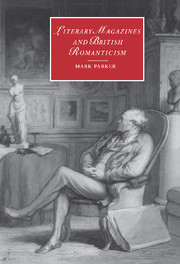Book contents
- Frontmatter
- Contents
- Acknowledgments
- Introduction: the study of literary magazines
- Chapter 1 Ideology and editing: the political context of the Elia essays
- Chapter 2 A conversation between friends: Hazlitt and the London Magazine
- Chapter 3 The burial of Romanticism: the first twenty installments of “Noctes Ambrosianae”
- Chapter 4 Magazine Romanticism: the New Monthly 1821–1825
- Chapter 5 Sartor Resartus in Fraser's toward a dialectical politics
- Conclusion
- Notes
- Bibliography
- Index
- Cambridge Studies in Romanticism
Conclusion
Published online by Cambridge University Press: 22 September 2009
- Frontmatter
- Contents
- Acknowledgments
- Introduction: the study of literary magazines
- Chapter 1 Ideology and editing: the political context of the Elia essays
- Chapter 2 A conversation between friends: Hazlitt and the London Magazine
- Chapter 3 The burial of Romanticism: the first twenty installments of “Noctes Ambrosianae”
- Chapter 4 Magazine Romanticism: the New Monthly 1821–1825
- Chapter 5 Sartor Resartus in Fraser's toward a dialectical politics
- Conclusion
- Notes
- Bibliography
- Index
- Cambridge Studies in Romanticism
Summary
The growth of a market for literary magazines between 1820 and 1834 provided a window of opportunity for writers with a particular kind of talent or genius. Lamb, Hazlitt, the Blackwood's crew, and Carlyle, as well as other more distant figures such as Horace Smith, Cyrus Redding, and John Scott all flourished under what was, compared to the periodical industry of the mid century, a relatively unregulated system of publication. Their search, as both editors and writers, for an answerable form, that is, one that would satisfy individual readers as well as the market (or markets) they make up collectively, led to some conspicuous individual successes as well as what is more rare in the history of literature – collaborative successes. Early in the decade three magazines manage (albeit sometimes only momentarily) to coalesce, to form coherent and well articulated worlds: the London under Scott, Blackwood's from 1822 to 1825, and the New Monthly under Campbell. The later success of a fourth, Fraser's, whose program was explicitly nostalgic for the early days of Blackwood's, hints at the increasing economic rationalization of the medium and a concomitant reluctance to experiment with form.
By considering literary magazines as something like a genre, a fuller account of literary activity in the 1820s and 1830s emerges, one through which we can begin to see the continuities that persist in what we have come to call Romanticism.
- Type
- Chapter
- Information
- Literary Magazines and British Romanticism , pp. 182 - 183Publisher: Cambridge University PressPrint publication year: 2001



